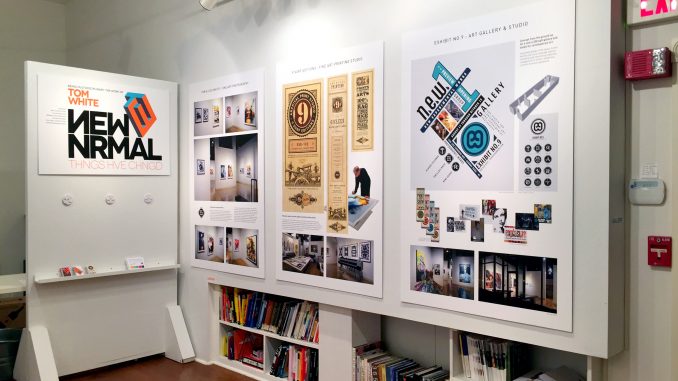
Philadelphia’s fine arts district resides within the most historic section of the city. Studios and galleries stand near Betsy Ross’ home and the country’s oldest residential street—all emblems of colonial American history.
Amid Old City’s charmingly aged atmosphere and cluster of artistic organizations, the recently built AIGA Philadelphia SPACE has something new to offer the neighborhood.
“Exhibition spaces don’t have to just be for fine art painting,” said Gaby Heit, the gallery’s director. “They can certainly be for graphic design. And since it is visual, I think that the work needs to be exhibited.”
Designer and gallery curator who fell in love with the Philly art scene, New York native Heit found a fitting career as SPACE director at the gallery near 2nd and Arch streets.
“I love where conceptual design becomes art, and how graphic design is considered art,” Heit said.
Established less than three years ago, the gallery provided a physical space for the AIGA Philadelphia chapter—a coalition of about 600 designers that formed in 1981.
The Philadelphia chapter is a single, albeit prominent, slice of an active organization: the American Institute of Graphic Arts (now known as The Professional Association for Design). Today, the more than 100-year-old AIGA includes about 70 chapters and 25,000 members including design fans to art students to veteran graphic designers.
“[Design] is one of the things I do,” said Tom White, who has spent almost 20 years working artistically for clients, from the New York Times to Radio City Music Hall. “I do many different things.”
He lists illustration, branding and brand expression under his line of work.
The owner of a contemporary art gallery and print shop in Asbury Park, New Jersey, White also doesn’t hesitate to work within the world of photography, where he sometimes collaborates with his also-artistic wife, Lois White, an aspect of his career that he refers to as “the fun part.”
In his exhibit at the AIGA Philadelphia gallery, “NEW NRMAL: THNGS HVE CHNGD,” White shows both art appreciators and ambitious designers a thriving example of how one can pursue a diversified artistic career.
“A lot of students might be interested in knowing, ‘Well, how can I do a little bit of everything?’ Heit said. “And there are ways that you can blend it. Instead of being a designer and maybe thinking, ‘Oh, I need to find other people to work with or see how we can collaborate,’ sometimes you can find out how you can be multidisciplinary and do it all.”
White started college as a physics major with no formal artistic training and an interest in typography and cartooning. He experienced a change of heart and career when he transferred to Syracuse University and eventually graduated with a degree in communications design.
When the computerized medium of design became present in the early 1990s, White immediately began digitizing his work, comparing the experience of his immersion in the digital world to “finding water again.” He tested the first versions of what are now considered standard design programs—Adobe Illustrator and Photoshop—and his early expertise helped to accelerate his career.
Although he cites technology as a major game-changer in the design world, White encourages artists not to depend solely on software.
“The most important thing is your brain,” White said. “I would get frequent emails from people saying ‘Oh, I really love your work. What program do you use?’ And my first answer is, ‘It doesn’t matter what program you use. Your thought process would be first.’”
Pointing out pictures of burnt, sienna-tinted vintage menus he designed for a beer garden in Asbury Park and glossy large-scaled murals for a healthcare company in the Midwest, White spoke enthusiastically of design history and how it can continue to inspire modern designers today. Though he often works through sketches and digital media, he’s influenced by Victorian craftsmanship of the 1880s and inspired by the marks of the mid-century modern movement in the 1940s and ‘50s. An important part of being a designer, White maintains, is having an awareness of design history.
“If you’re a designer, you shouldn’t be pigeonholed into being able to design in only one kind of genre,” White said. “If you have a client that wants ‘50s modern, you should know how to design that. And you should not say, ‘Well, I can’t do that.’”
Both White’s personal work and the AIGA Philadelphia SPACE, which has organized everything from a map exhibit to a neon sign display to an educator’s art show, continue to present the diversity that a career in design can entail.
White’s work will remain at the AIGA Philadelphia SPACE until Aug. 30.
Angela Gervasi can be reached at angela.gervasi@temple.edu.


Be the first to comment